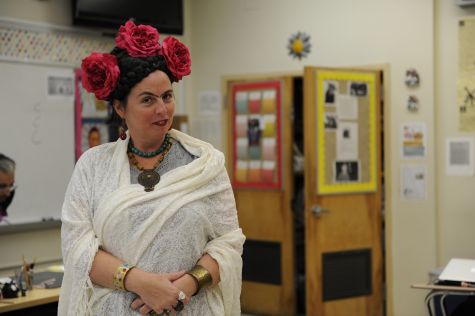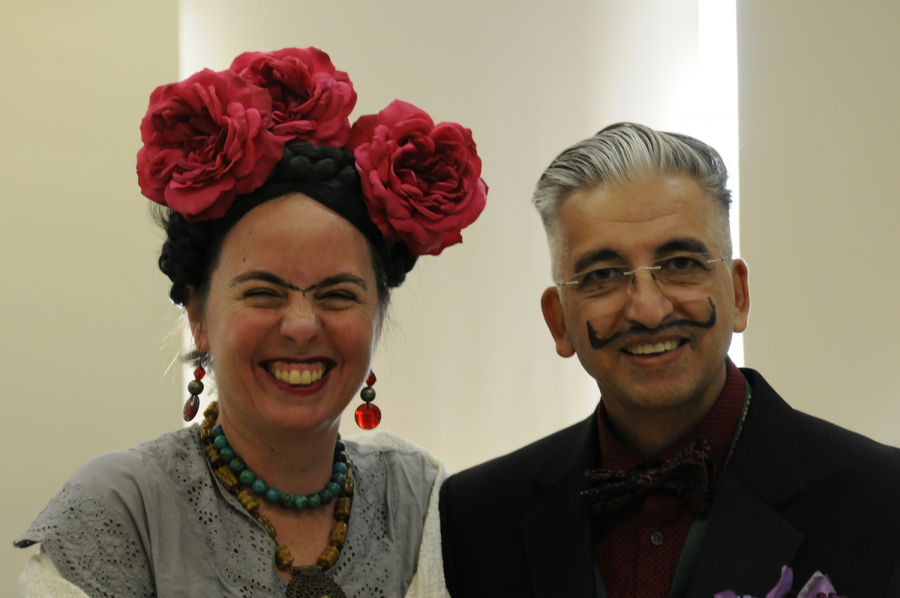From Orthopedic Corsets to Torzalas
A Review of the Brooklyn Museum’s Recent Frida Kahlo Exhibit
AP Spanish Teachers Sra. Olmedo and Sr. San Martin pose in costume together as Diego and Frida.
Brightly painted lips and a defiant gaze resting below a single brow: Frida Kahlo’s trademark features have turned the artist herself into an ubiquitous image. The artist behind said image was beautifully encapsulated by the incredible exhibit dedicated to her showing at the Brooklyn Museum from February 8th to May 12th, 2019. Through a plethora of personal photos, clothing, leather-bound diaries, and other artifacts, viewers of the show got a seldom seen and deeply intimate look into one of the greatest artists of the twentieth century.
The show opened with a short clip of Frida, laughing and talking, projected against a wall. As a viewer, I felt a brief moment of shock at seeing her move through the world, as opposed to the stagnance she has taken on in my perception of her. But once the cognitive dissonance faded, it was immediately apparent what attracted so many to her. Languid gesticulations and melting smiles gave her an undeniable charisma, magnetizing any spectator towards her even through the barrier of film.
This sentiment was only heightened through intimate pictures from incredible photographers, such as Lola Álvarez Bravo and Nickolas Muray, which coated the walls. As close friends and lovers, they took portraits so close and personal, it feels as though the viewer is standing in the same confidence she had endowed the photographers. These gorgeous pictures are accompanied by small anecdotes that demonstrate the broad scope of influence Frida wielded upon those in her community. One photo of her sitting near a market stall is paired with a line from a local vendor, who fondly recalled that, while Frida searched for interesting trinkets in local areas, “she never bargained.”
“I think it’s very interesting how Frida Kahlo has been whitewashed by mainstream history and most people divorce her art from her politics. Most people don’t know that she was part of the Mexican Communist Party and that she was a staunch opponent of capitalism, colonialism, and racism,” said Daniel Iskhakov ’19. No attempt to separate Frida from her radical nature was present in this show. Instead, her activism is embraced with unabashed appreciation and she is lauded for every and all of her deviations from the norm. Plaster casts that Frida decorated with communist iconography and letters to other radical activists are proudly displayed with other items in the collection.
“I think it’s very interesting how Frida Kahlo has been whitewashed by mainstream history and most people divorce her art from her politics. Most people don’t know that she was part of the Mexican Communist Party and that she was a staunch opponent of capitalism, colonialism, and racism,” said Daniel Iskhakov ’19.
This activist spirit was further emboldened through her relationship to fellow artist, Diego Rivera. Both Diego and Frida were strong proponents of the “Mexicanidad” movement and took pride in their Mexican heritage. In their separate homes, they held a massive collection of ceramics from indigenous Mexican sculptors and hundreds of votive printages (“retablos”) were hung in Frida’s kitchen in a church-like manner. Frida’s sprawling “Casa Azul” was filled with paintings and various trinkets given to her by globe trotting friends and fellow artists. Within her backyard, she kept pet dogs, parrots, monkeys, and a fawn, as well as plenty of apricot, orange, and pine trees. Her house was frequently referred to as a “microcosm of Mexico” and she often proclaimed that “aquí nací” [“here I was born”].

Advanced Placement Spanish Teacher, Sra. Olmedo, poses in costume as Frida Kahlo for Halloween.
Beyond her house, Frida also expressed her trailblazer spirit and Mexican identity through her clothing. In the exhibit, spectators could walk through a massive room full of mannequins modeling flowing tehuana dresses, embroidered huipil blouses, and gender non-conformant suits. Featured beside these outfits were sunglasses, beauty products (Revlon was her favorite brand!), and “torzalas” (coin laden dowry necklaces).
A significant portion of the exhibit was also devoted to her relationship with her husband, Diego. Throughout her lifetime, Diego often overshadowed Frida in the press, but Frida never doubted her own skill and once stated, “No pinta nada mal para ser un chiquillo, pero yo soy la verdadera artista” [“He doesn’t paint badly for a kid, but I am the real artist”]. Despite their disparity in recognition and the tumultuous nature of their on-again-off-again relationship, the deep affection between them is depicted through small love notes that they wrote to each other [“A la niña fisita, del [little frog doodle] con un 10000000 de besos”/”To the girl Fisita, from [from] with 10000000 of kisses”] and photos of them with Frida’s looping script labeling them in accordance with their pet-names for each other [“Fisita” and “Sapo” (frog!)].
“She was a revolutionary artist and had an incredibly interesting life,” said Candace McQuaig ’18. This is certainly demonstrated throughout the show. Filled with items such as the old perfume bottles Frida put tequila in and carried around with her to the dolls she made in her own likeness to the collection of Walt Whitman’s poetry that was found at her bedside when she died in 1954, the Brooklyn museum’s show was a wonderful accumulation of ephemera from an illustrious life that was definitely worth a visit.
Julia Catrambone is a Copy Chief for the ‘The Science Survey’ and a Staff Reporter for ‘The Observatory.’ As Copy Chief, she edits articles by...
Akaneh Wang is a Graphic Designer for ‘The Observatory’ yearbook. She has loved to draw and design ever since she was given her first set of crayons....
Daniela Castro is an Editor-in-Chief of the ‘The Science Survey’ and a Reporter for the People Section in the Bronx Science Yearbook, ‘The Observatory.’...

